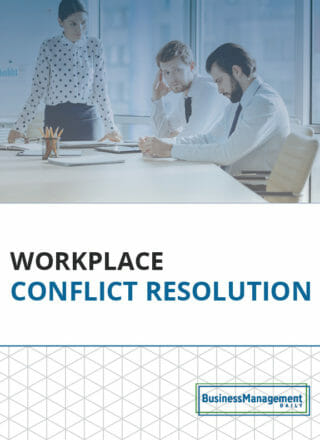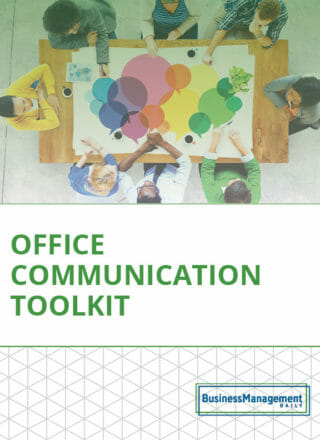How to run better meetings and stop wasting time

Employees frequently complain about boring or bad meetings eating up too much of their work day. Ineffective meetings can detract from more productive uses of your employees’ time. But how do you run better meetings?
Running a successful meeting requires extensive planning and strong facilitation skills. Meeting facilitation is often overlooked as a leadership skill or grouped with public speaking.
However, much work and practice goes into running great meetings.
Perhaps you’re unsure where to start improving your meetings. Or maybe you’ve recently realized your employees dislike the current meeting process.
In either case, keep reading. This information will help you learn how to run better meetings.
The ten steps of running an effective meeting
One of the easiest ways to host a lousy meeting is to rush the process and skip over crucial steps. To avoid this, allocate time to planning and working through these ten steps.
Verify that a meeting is necessary
Before you send out that meeting invite, consider whether this meeting is necessary in the first place. You want to make the best use of your employees’ time and are paying for that time. So ensure you’re only scheduling genuinely good meetings using those resources.
Where possible, consider alternatives to meetings like email. Sending an informational email instead of a meeting is a good option if you don’t actively need employees to provide input or expect whatever you are discussing to solicit questions or have a significant emotional impact.
It can also help to ask, “Does this topic warrant its meeting?”. Some topics work better as add-ons to existing meeting agendas or daily standup team meetings rather than necessitating a separate meeting.
Try not to overload employees with too many individual meeting invites by condensing topics where practical.
Define the purpose of the meeting
A good meeting will have a clear purpose. Define why you are holding a meeting and identify what you hope to accomplish. Meetings are great for decision-making, but your goal doesn’t always have to be to reach a specific decision.
You can run meetings to share information, encourage team building, and solicit employee feedback. Knowing the end goal of each particular meeting will help you understand how to guide the conversation correctly.
This approach helps you identify a clear end point for your meeting. It’s better to end a meeting early once you achieve your goal. You shouldn’t drag it out just to fill the scheduled time.
Ensure that the purpose of the meeting is clear to meeting participants as well. You can state the purpose of the meeting when you send out the meeting invitation and repeat it on the agenda or at the start of the meeting.
Ensure the objective is clear and concrete so that employees understand why they must attend and have accurate expectations for the meeting.
Create and distribute a clear agenda
Productive meetings have a clear purpose and an action plan. Crafting an agenda helps you stay on track and organized while discussing meeting topics and gives others a clear picture of what will be discussed.
Aim to distribute the agenda several days before the meeting so that attendees can come prepared with relevant questions, ideas, or materials to share based on the planned topics.
Leave time for employee contributions
One mistake many new meeting leaders make is overloading the agenda so employees don’t have enough time to speak up, ask questions, or share ideas. Your meeting should be structured, but don’t feel you need to plan for and fill up every second.
Be sure to leave room in your meeting plan for brainstorming, discussion, and questions so that you’re talking with employees rather than just at them throughout the meeting.
If there isn’t time for collaboration or questions, your meeting will often feel like a “meeting that could have been an email” rather than a productive use of your employees’ time.
However, once you get people involved in group problem-solving and brainstorming, you can extract meaningful information and ideas from a meeting.
Start the meeting on time
Start your meetings on time or close to the start time whenever possible. It’s natural for people to be a few minutes late, especially if they have back-to-back meetings or a virtual meeting where a few attendees may encounter technical difficulties.
However, unless one of the latecomers will be the main contributor for your first agenda item, it’s best not to wait for them. If you start more than a few minutes late, the employees who arrive on schedule or early will feel like their time is wasted.
Have someone take notes
Meeting notes, or meeting minutes, help document what was shared and decided on during the meeting. Assign note-taking to another person, as trying to take detailed meeting notes while leading the meeting, can be challenging and will likely result in you doing a subpar job at both tasks.
Distribute these notes to all participants after the meeting; anyone absent will need the information included to get caught up on what was discussed.
Stay on topic
Don’t let anyone, including yourself, go off on long, unrelated tangents. Meeting leaders can be just as guilty as participants of leading the conversation astray. Still, if you have an organized and well-prepared agenda, staying on topic and moving swiftly through planned talking points should be more accessible.
If the meeting starts getting too far off-topic, the facilitator should gently but firmly bring the conversation back to the agenda item or discussion point that should be in focus. Attendees amy try to skip ahead to an item further down your agenda.
Remind them there will be plenty of time to discuss that matter later in the meeting, and ask them to hold their thoughts on the topic for now. If an unrelated topic warrants discussion, schedule a separate meeting to address it.
Encourage healthy discussion while shutting down unproductive conflict
Managers and meeting leaders must find a balance. They need to encourage different viewpoints. They should also welcome constructive feedback. At the same time, they must be ready to act. They need to shut down disrespectful or harmful contributions.
This should be done promptly. You must create an environment where people feel comfortable speaking up without judgment, disrespect, or undue negativity.
Remember, healthy conflict leads to great ideas and better decision-making, so you should allow respectful debate or pushback when it feels relevant and productive.
One way to differentiate between unproductive contrarian behavior and thoughtful criticism can be to ask for solutions. If someone sees an apparent problem with a coworker’s suggestion or even a company’s new policy or process, it’s worthwhile to hear their suggestion on how to fix it.
However, people who criticize without interest in brainstorming solutions may not provide constructive feedback and can bring down morale during the meeting.
Know when to end the meeting
Keep the meeting from dragging on unproductively. Do your best to end the meeting on time and respect the meeting participants’ time. However, you also shouldn’t be afraid to end the meeting early. Sometimes, the goal is achieved early, or you may reach a logical stopping point in the discussion.
Sometimes it becomes clear that the group needs more information. This could be to fully explore a topic or to reach a decision. In this case, don’t hesitate to end the meeting early. Then, schedule a follow-up meeting. This should happen once everyone has gathered the necessary data or information.
It’s also a good idea to keep an eye on the pulse of the meeting. If people seem burnt out from discussion and ready to be done, try to start wrapping things up.
Document required follow-up and action items
At the end of the meeting, summarize the necessary action items and who will be responsible for each one. The designated note-taker can help track these as you move through the meeting. After the meeting, include this list of required follow-up and action items in a post-meeting email (along with your other meeting notes).
Remember that many of your participants are busy and likely had to rush off to another meeting or important job task. So it’s easy to forget to write things down or lose track of what they need to do before the next meeting. Documentation helps make the process easier for all parties.
Special considerations for running remote meetings
Remote work meetings have become increasingly common over the last several years, but many managers still need help leading effective ones.
Decide whether the video should be required
Part of this choice comes down to knowing your team. If most of your team members are introverts who prefer to stay muted during meetings, they may prefer having cameras off (and may be able to focus better too).
People in remote roles that typically don’t require daily virtual meetings will also appreciate the option to keep the camera off so they don’t feel like they have to get “camera ready” just for one call.
Another factor to consider is “Zoom fatigue” or remote meeting fatigue. Being on camera for prolonged video calls is tiring, and this added fatigue can make it hard for people to focus or contribute fully during calls. Harvard Business Review notes that Zoom fatigue is mainly due to how people process information during video calls.
It’s somewhat unnatural to look at yourself and to make consistent eye contact with your screen throughout an entire meeting, so it’s understandable that always having cameras on could be draining.
If you’re a team leader with many meetings, vary things by keeping cameras off for some or designating a “no cameras” meeting day. The meetings that you typically want cameras on are the more collaborative or team-building meetings.
Limit the guest list
As with any meeting, you should be intentional about who you invite. It’s easier to accidentally talk over each other during crowded remote meetings, which can make brainstorming a bit chaotic if there are too many people.
Many managers also tend to over-invite to remote meetings. There’s not a clear physical capacity limit as there would be in an in-person meeting room. Inviting extra people who likely won’t contribute often wastes time for these added attendees.
One particular thing to remember for remote meetings is that you can record the call and share it with other team members afterward. This is a good tool for primarily informational rather than collaborative meetings.
Sometimes meetings involve giving a tutorial or explanation. This might be about a new system, process, or product feature. In these cases, consider making attendance optional.
Also, let your team members know they can watch a recording. This is helpful if they can’t attend the live session. The employees who like to speak up and ask questions will typically still attend.
At the same time, those who prefer to listen or feel overloaded with other priorities on the day of the meeting can skip it and watch the recording later.
Minimize distractions and multi-tasking
Both remote and in-person meetings can cause anxiety for employees. They may worry about falling behind on their work. Additionally, they might fear missing important events during the meeting, such as customer calls or emails.
However, this concern is often more disruptive during remote meetings. This is because it’s easier to multitask subtly during a remote meeting.
However, employees focused on their email inbox or another project will likely miss out on crucial information during the meeting and are less likely to contribute to discussions. Having cameras on can help limit multi-tasking.
However,it’s often difficult to tell whether someone is taking notes during the meeting or answering an unrelated message.
As a supervisor or manager, acknowledge the impact of meetings. Let your team know you understand that meetings take away from their work time. Therefore, encourage them to adjust their schedules.
Specifically, they can shift work around and use effective time management techniques. These techniques include prioritizing tasks. They also include communicating when they cannot complete all tasks within the allotted time.
Also, avoid creating a work culture where people expect unlimited access to their colleagues. Employees often feel pressured to constantly check and reply to messages.
However, companies can minimize this feeling. They can encourage employees to step away from messaging. This allows them to focus on meetings or important tasks.
Additional resources – Opens in new tab:
Virtual meeting problems & how to solve them
Meetings are bad—should we cancel them all?
Make the most of Monday morning meetings (or don’t have them)




